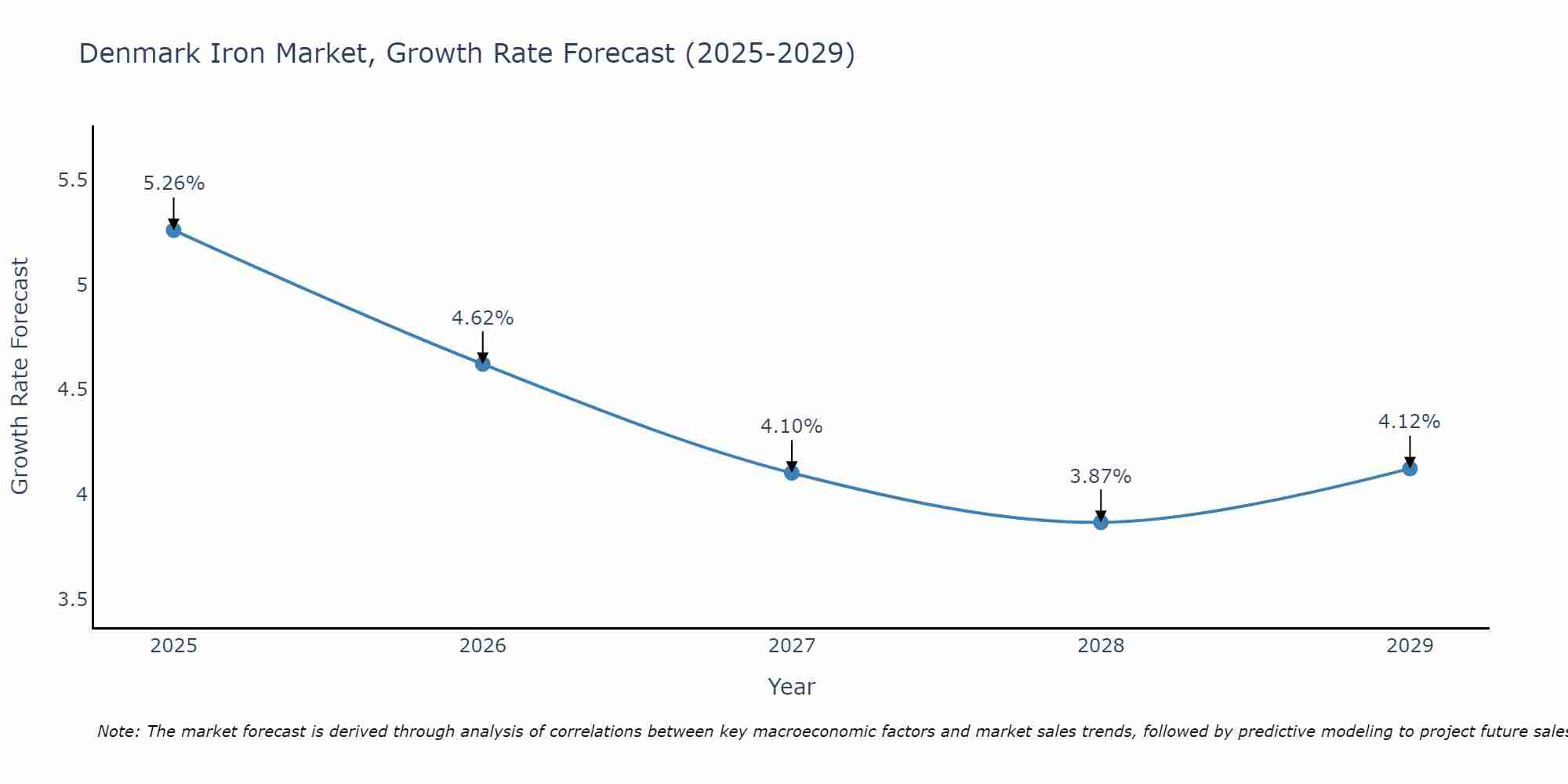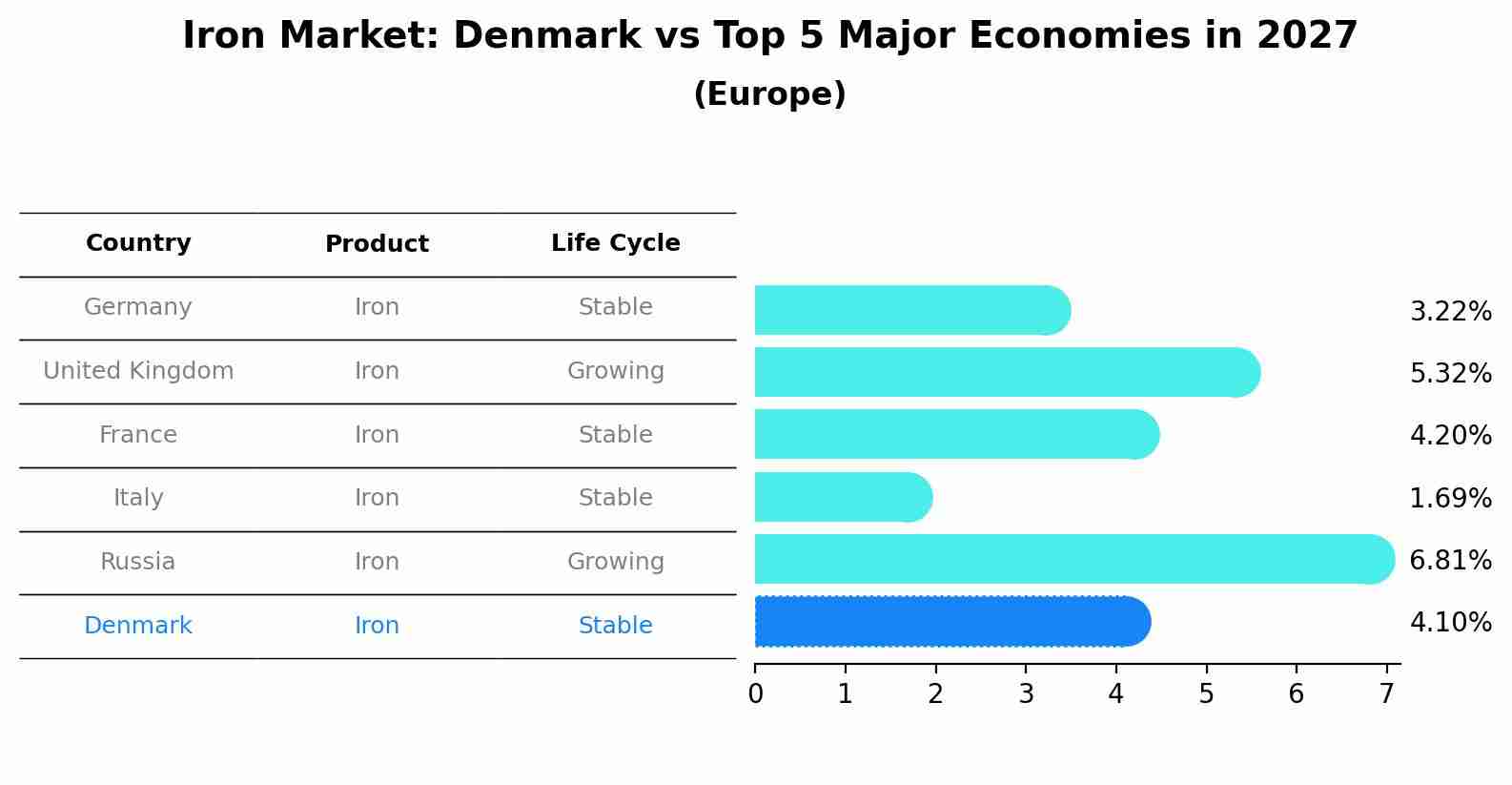Denmark Iron Market (2025-2031) | Growth, Analysis, Forecast, Trends, Segmentation, Companies, Value, Size, Outlook, Share, Industry & Revenue
| Product Code: ETC4653695 | Publication Date: Nov 2023 | Updated Date: Oct 2025 | Product Type: Market Research Report | |
| Publisher: 6Wresearch | Author: Shubham Padhi | No. of Pages: 60 | No. of Figures: 30 | No. of Tables: 5 |
Denmark Iron Market Size Growth Rate
The Denmark Iron Market is projected to witness mixed growth rate patterns during 2025 to 2029. Starting high at 5.26% in 2025, the market steadily declines to 4.12% by 2029.

Iron Market: Denmark vs Top 5 Major Economies in 2027 (Europe)
The Iron market in Denmark is projected to grow at a stable growth rate of 4.10% by 2027, highlighting the country's increasing focus on advanced technologies within the Europe region, where Germany holds the dominant position, followed closely by United Kingdom, France, Italy and Russia, shaping overall regional demand.

Key Highlights of the Report:
- Denmark Iron Market Outlook
- Market Size of Denmark Iron Market, 2024
- Forecast of Denmark Iron Market, 2031
- Historical Data and Forecast of Denmark Iron Revenues & Volume for the Period 2021-2031
- Denmark Iron Market Trend Evolution
- Denmark Iron Market Drivers and Challenges
- Denmark Iron Price Trends
- Denmark Iron Porter`s Five Forces
- Denmark Iron Industry Life Cycle
- Historical Data and Forecast of Denmark Iron Market Revenues & Volume By Material Types for the Period 2021-2031
- Historical Data and Forecast of Denmark Iron Market Revenues & Volume By PureIron for the Period 2021-2031
- Historical Data and Forecast of Denmark Iron Market Revenues & Volume By WroughtIron for the Period 2021-2031
- Historical Data and Forecast of Denmark Iron Market Revenues & Volume By Cast Iron for the Period 2021-2031
- Historical Data and Forecast of Denmark Iron Market Revenues & Volume By Pig Iron for the Period 2021-2031
- Historical Data and Forecast of Denmark Iron Market Revenues & Volume By Direct Reduced Iron for the Period 2021-2031
- Historical Data and Forecast of Denmark Iron Market Revenues & Volume By Applications for the Period 2021-2031
- Historical Data and Forecast of Denmark Iron Market Revenues & Volume By Building for the Period 2021-2031
- Historical Data and Forecast of Denmark Iron Market Revenues & Volume By Construction for the Period 2021-2031
- Historical Data and Forecast of Denmark Iron Market Revenues & Volume By Railways for the Period 2021-2031
- Historical Data and Forecast of Denmark Iron Market Revenues & Volume By Fertilizers for the Period 2021-2031
- Historical Data and Forecast of Denmark Iron Market Revenues & Volume By Industrial Uses for the Period 2021-2031
- Historical Data and Forecast of Denmark Iron Market Revenues & Volume By Others for the Period 2021-2031
- Denmark Iron Import Export Trade Statistics
- Market Opportunity Assessment By Material Types
- Market Opportunity Assessment By Applications
- Denmark Iron Top Companies Market Share
- Denmark Iron Competitive Benchmarking By Technical and Operational Parameters
- Denmark Iron Company Profiles
- Denmark Iron Key Strategic Recommendations
Frequently Asked Questions About the Market Study (FAQs):
1 Executive Summary |
2 Introduction |
2.1 Key Highlights of the Report |
2.2 Report Description |
2.3 Market Scope & Segmentation |
2.4 Research Methodology |
2.5 Assumptions |
3 Denmark Iron Market Overview |
3.1 Denmark Country Macro Economic Indicators |
3.2 Denmark Iron Market Revenues & Volume, 2021 & 2031F |
3.3 Denmark Iron Market - Industry Life Cycle |
3.4 Denmark Iron Market - Porter's Five Forces |
3.5 Denmark Iron Market Revenues & Volume Share, By Material Types, 2021 & 2031F |
3.6 Denmark Iron Market Revenues & Volume Share, By Applications, 2021 & 2031F |
4 Denmark Iron Market Dynamics |
4.1 Impact Analysis |
4.2 Market Drivers |
4.2.1 Increasing demand for iron in construction and infrastructure projects in Denmark |
4.2.2 Growing focus on sustainability and eco-friendly practices leading to higher demand for recycled iron |
4.2.3 Government initiatives and investments in infrastructure development driving the iron market growth in Denmark |
4.3 Market Restraints |
4.3.1 Fluctuating prices of iron ore impacting the cost of production in the Denmark iron market |
4.3.2 Competition from alternative materials like aluminum and composites affecting the market share of iron |
4.3.3 Regulatory challenges and environmental concerns related to iron production and usage in Denmark |
5 Denmark Iron Market Trends |
6 Denmark Iron Market Segmentations |
6.1 Denmark Iron Market, By Material Types |
6.1.1 Overview and Analysis |
6.1.2 Denmark Iron Market Revenues & Volume, By Pure? Iron, 2021-2031F |
6.1.3 Denmark Iron Market Revenues & Volume, By Wrought? Iron, 2021-2031F |
6.1.4 Denmark Iron Market Revenues & Volume, By Cast Iron, 2021-2031F |
6.1.5 Denmark Iron Market Revenues & Volume, By Pig Iron, 2021-2031F |
6.1.6 Denmark Iron Market Revenues & Volume, By Direct Reduced Iron, 2021-2031F |
6.2 Denmark Iron Market, By Applications |
6.2.1 Overview and Analysis |
6.2.2 Denmark Iron Market Revenues & Volume, By Building, 2021-2031F |
6.2.3 Denmark Iron Market Revenues & Volume, By Construction, 2021-2031F |
6.2.4 Denmark Iron Market Revenues & Volume, By Railways, 2021-2031F |
6.2.5 Denmark Iron Market Revenues & Volume, By Fertilizers, 2021-2031F |
6.2.6 Denmark Iron Market Revenues & Volume, By Industrial Uses, 2021-2031F |
6.2.7 Denmark Iron Market Revenues & Volume, By Others, 2021-2031F |
7 Denmark Iron Market Import-Export Trade Statistics |
7.1 Denmark Iron Market Export to Major Countries |
7.2 Denmark Iron Market Imports from Major Countries |
8 Denmark Iron Market Key Performance Indicators |
8.1 Percentage of iron used in construction projects sourced from recycled materials |
8.2 Number of infrastructure projects using iron as a primary material in Denmark |
8.3 Energy efficiency improvements in iron production processes in the Denmark market |
9 Denmark Iron Market - Opportunity Assessment |
9.1 Denmark Iron Market Opportunity Assessment, By Material Types, 2021 & 2031F |
9.2 Denmark Iron Market Opportunity Assessment, By Applications, 2021 & 2031F |
10 Denmark Iron Market - Competitive Landscape |
10.1 Denmark Iron Market Revenue Share, By Companies, 2024 |
10.2 Denmark Iron Market Competitive Benchmarking, By Operating and Technical Parameters |
11 Company Profiles |
12 Recommendations | 13 Disclaimer |
- Single User License$ 1,995
- Department License$ 2,400
- Site License$ 3,120
- Global License$ 3,795
Search
Thought Leadership and Analyst Meet
Our Clients
Related Reports
- Germany Breakfast Food Market (2026-2032) | Industry, Share, Growth, Size, Companies, Value, Analysis, Revenue, Trends, Forecast & Outlook
- Australia Briquette Market (2025-2031) | Growth, Size, Revenue, Forecast, Analysis, Trends, Value, Share, Industry & Companies
- Vietnam System Integrator Market (2025-2031) | Size, Companies, Analysis, Industry, Value, Forecast, Growth, Trends, Revenue & Share
- ASEAN and Thailand Brain Health Supplements Market (2025-2031) | Strategy, Consumer Insights, Analysis, Investment Trends, Opportunities, Growth, Size, Share, Industry, Revenue, Segments, Value, Segmentation, Supply, Forecast, Restraints, Outlook, Competition, Drivers, Trends, Demand, Pricing Analysis, Competitive, Strategic Insights, Companies, Challenges
- ASEAN Bearings Market (2025-2031) | Strategy, Consumer Insights, Analysis, Investment Trends, Opportunities, Growth, Size, Share, Industry, Revenue, Segments, Value, Segmentation, Supply, Forecast, Restraints, Outlook, Competition, Drivers, Trends, Demand, Pricing Analysis, Competitive, Strategic Insights, Companies, Challenges
- Europe Flooring Market (2025-2031) | Outlook, Share, Industry, Trends, Forecast, Companies, Revenue, Size, Analysis, Growth & Value
- Saudi Arabia Manlift Market (2025-2031) | Outlook, Size, Growth, Trends, Companies, Industry, Revenue, Value, Share, Forecast & Analysis
- Uganda Excavator, Crane, and Wheel Loaders Market (2025-2031) | Strategy, Consumer Insights, Analysis, Investment Trends, Opportunities, Growth, Size, Share, Industry, Revenue, Segments, Value, Segmentation, Supply, Forecast, Restraints, Outlook, Competition, Drivers, Trends, Demand, Pricing Analysis, Competitive, Strategic Insights, Companies, Challenges
- Rwanda Excavator, Crane, and Wheel Loaders Market (2025-2031) | Strategy, Consumer Insights, Analysis, Investment Trends, Opportunities, Growth, Size, Share, Industry, Revenue, Segments, Value, Segmentation, Supply, Forecast, Restraints, Outlook, Competition, Drivers, Trends, Demand, Pricing Analysis, Competitive, Strategic Insights, Companies, Challenges
- Kenya Excavator, Crane, and Wheel Loaders Market (2025-2031) | Strategy, Consumer Insights, Analysis, Investment Trends, Opportunities, Growth, Size, Share, Industry, Revenue, Segments, Value, Segmentation, Supply, Forecast, Restraints, Outlook, Competition, Drivers, Trends, Demand, Pricing Analysis, Competitive, Strategic Insights, Companies, Challenges
Industry Events and Analyst Meet
Whitepaper
- Middle East & Africa Commercial Security Market Click here to view more.
- Middle East & Africa Fire Safety Systems & Equipment Market Click here to view more.
- GCC Drone Market Click here to view more.
- Middle East Lighting Fixture Market Click here to view more.
- GCC Physical & Perimeter Security Market Click here to view more.
6WResearch In News
- Doha a strategic location for EV manufacturing hub: IPA Qatar
- Demand for luxury TVs surging in the GCC, says Samsung
- Empowering Growth: The Thriving Journey of Bangladesh’s Cable Industry
- Demand for luxury TVs surging in the GCC, says Samsung
- Video call with a traditional healer? Once unthinkable, it’s now common in South Africa
- Intelligent Buildings To Smooth GCC’s Path To Net Zero


















